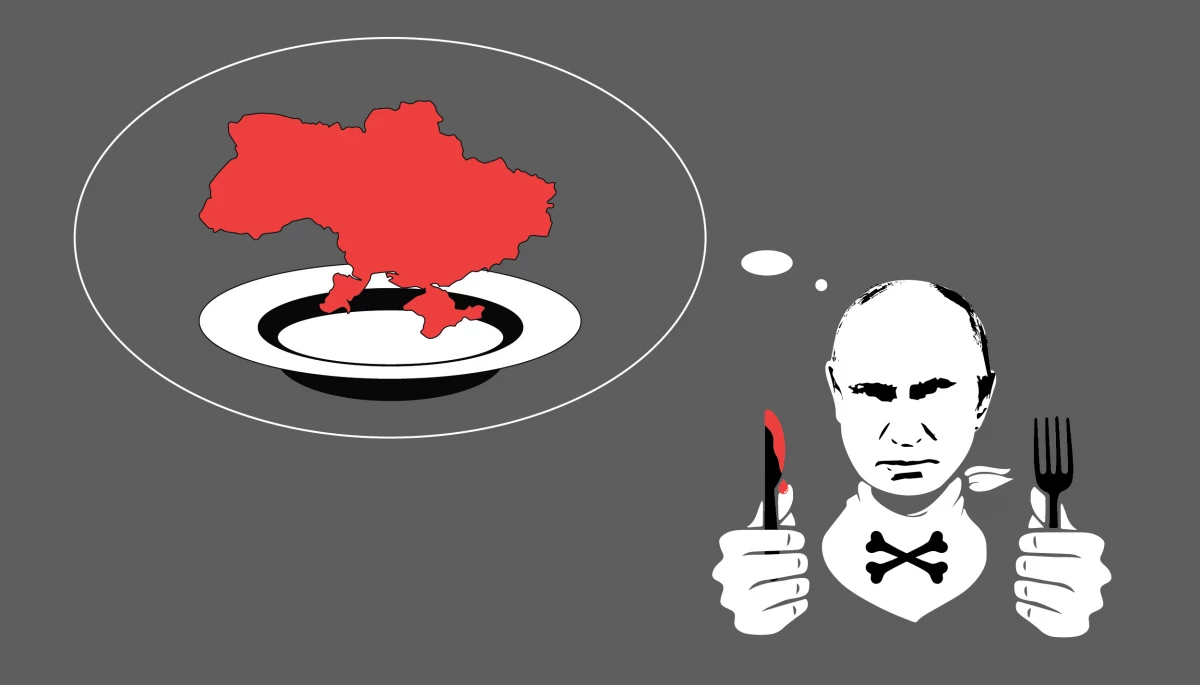

Українською читайте тут.
Rhetorical references to the so-called "Istanbul Agreements" of 2022 and Putin's ultimatum are intended to undermine the unity of Ukraine and its allies, pressuring them into a "ceasefire" that would merely serve as a prelude to further occupation of Ukrainian territories and the Kremlin's dominance in any negotiations.
Russian propaganda and officials have consistently asserted their willingness to engage in "peace talks" with Ukraine and Western countries, but strictly on "their own terms." The negotiations between Russian and Ukrainian delegations in Istanbul in the spring of 2022, along with the "Minsk Accords" concluded before the full-scale invasion, are central to this narrative. The Kremlin attempts to frame the situation as though their initial demands were "limited" and "mutually beneficial." However, they claim that the "intransigence" of Kyiv, Washington, and European politicians has led to the deterioration of negotiation conditions for Ukraine. According to this narrative, the responsibility for the war falls on Ukraine and its allies for their refusal to accept these terms.
Previously, we explored how Russia devalues the Global Peace Summit and the Ukrainian "peace formula," and how Moscow manipulates various peace plan scenarios. Vladimir Putin's "new peace proposal," announced a day before the Swiss Peace Summit, along with the probable draft version of the "Istanbul Agreements" published by The New York Times, provide a basis for analyzing the core of the Kremlin's demands, what they are actually proposing, and what their ultimate goals are.
Putin's "Zaporizhzhia-Kherson" ultimatum
On June 14, on the eve of the Peace Summit organized by Ukraine, Putin announced what he called a "real peace proposal." For the first time, he demanded that Ukraine cede the entire Zaporizhzhia, Kherson, Donetsk, and Luhansk regions to Russia. This demand included areas such as liberated Kherson and Zaporizhzhia, which Russian troops have not even come close to capturing.
While this territorial demand was the most notable part of Putin's "proposal," it was not the only one. The Kremlin also seeks Ukraine's refusal to join NATO, recognition of the annexation of Crimea, and a "non-aligned and neutral" status for Ukraine. According to Putin, these demands are merely "prerequisites" for further negotiations and "the beginning of a dialogue on which the future existence of Ukraine depends." One can infer that these talks would also cover the "demilitarization and denazification" of Ukraine, terms Putin mentioned. "Everyone generally agreed to these parameters during the Istanbul negotiations, and everything was clear about demilitarization, everything was spelled out," Putin stated. In the likely event of Ukraine rejecting his "offers," he threatened a "continuation of bloodshed" and placed the responsibility for this on "Kyiv and the Western capitals."
The Ministry of Foreign Affairs of Ukraine labeled Putin's statements as an attempt to "impede the participation of leaders and countries" in the peace summit in Switzerland. "The timing of Putin's statements, coming exactly a day before the summit, shows that Russia is afraid of real peace," the Ministry stated. Ukrainian President Volodymyr Zelensky remarked that Putin's "proposals" are ultimatums, no different from previous demands. He compared the Kremlin's demands to those of Adolf Hitler before World War II: "He said: give me a part of Czechoslovakia, and that will be the end of it. This is a historical lie. After that, there was Poland - give me a part of Poland, then the occupation of all of Europe... Putin is following the same path."
Regarding the consistency of Putin's latest "peace proposal" with Russia's previous policies and demands, the Kremlin has long claimed five regions of Ukraine. This was evident during the imitation of the so-called "referendums" in the occupied territories and the "admission" of Kherson, Zaporizhzhia, Donetsk, and Luhansk regions into Russia.
However, until now, Putin had not directly demanded that Ukraine withdraw troops from Zaporizhzhia and Kherson. Instead, he spoke mainly about negotiations "taking into account the situation on the ground." This vague phrasing could be interpreted as a "peace proposal" to halt the war along the current front lines. Now, however, Putin explicitly demands the transfer of several key areas to Russia: first, the Ukrainian army's fortifications in eastern Ukraine, including the Kramatorsk-Slovyansk urban agglomeration; second, Kherson and its strategic bridgehead on the right bank of the Dnieper; third, Zaporizhzhia, one of Ukraine's largest industrial centers, along with the Dnipro HPP and another bridgehead on the Right Bank. Following these demands, Putin suggests there would be "negotiations," during which further conditions, such as "demilitarization" under the so-called "Istanbul agreements," would be imposed on Ukraine.
According to the authors, Zelensky's comparison of Putin's "peace proposal" to the Czechoslovak situation of 1938 is quite fitting. If Ukraine and its allies were to accept Putin's demands, their ability to defend against Russian troops would be severely compromised, paving the way for further occupation of Ukrainian territories and allowing the Kremlin to dictate further terms. This is similar to the "Munich Agreement," where the Sudetenland of Czechoslovakia was handed over to Germany with the consent of Britain and France, leading to Prague falling under German control soon after.
During the peace summit, Dutch Prime Minister Mark Rutte called Putin's statement a "crazy proposal," suggesting that the Kremlin leader is "panicking." This view is shared by many Western and Ukrainian observers. However, it remains an open question whether these ultimatum "proposals" indicate Moscow's weakness, as it attempts to initiate negotiations, or reflect the Kremlin's confidence in a favorable outcome, allowing it to "raise the stakes."
The authors believe that Putin's words are part of a broader Kremlin strategy to pressure Ukraine and, perhaps more importantly, its Western partners. This strategy can be summarized as "agree to our terms now, or it will be worse later." From this perspective, Putin's demands are a demonstrative move to intimidate opponents by creating the impression of worsening conditions for negotiations, thereby forcing them to accept the Kremlin's current terms. This tactic was underscored by Putin's press secretary, Dmytro Peskov, who noted that the situation was "better" in the spring of 2022 when Russia did not officially claim the Kherson and Zaporizhzhia regions: "Today, the situation is obviously different de facto and de jure... Then the situation will also be different, and here the Ukrainian side just needs to think."
But should we really view the Kremlin's current demands as final? And what exactly were the so-called "Istanbul agreements" frequently mentioned by Russian propagandists?
Were Kyiv and Moscow close to a realistic peace agreement in the spring of 2022?
On June 15, 2024, The New York Times published detailed drafts of peace agreements from the Russian-Ukrainian negotiations in the spring of 2022. These drafts, dated March 17 and April 15, 2022, were made available in English, with the latter also presented in its original Russian version sent to Putin. The article was authored by Pulitzer Prize winners Anton Troianovski, Adam Entous, and Michael Schwirtz.
The documents were verified by sources from Ukraine, Russia, and Europe, with authenticity confirmed by participants in the negotiations and other close associates. Portions of the draft agreements had previously been reported in Western media, including Faridaily, The Wall Street Journal, and Foreign Affairs, as well as by Ukrainian negotiators, and these earlier reports are consistent with the full drafts now published by The New York Times.
As of June 20, neither official Moscow nor Kyiv have confirmed or denied the authenticity of the draft agreements, though their content remains sensitive for both parties. Moscow seemingly conceded parts of the occupied Ukrainian territories, while Kyiv agreed to certain restrictions on its foreign and security policies. These factors suggest the probable authenticity of the drafts presented to The New York Times, highlighting them as working documents without legal force. It remains unclear how committed both sides were to finalizing these negotiations, or if these documents were merely strategic diversions. Nevertheless, the files provide insight into the negotiations.
The documents feature distinct formatting to highlight the unresolved points between the parties, allowing for differentiation between Ukrainian and Russian proposals for final revisions. According to the April 15, 2022, documents, Kyiv appeared willing to make several compromises: imposing restrictions on its sovereign foreign policy, specifically by introducing a neutral status in the Constitution that would preclude NATO membership (paragraphs 1 and 3 of Article 1) but allow for EU membership (Article 3); tacitly, though not legally, accepting the occupation of certain internationally recognized Ukrainian territories, including Crimea (Articles 8 and 9); and establishing unilateral limitations on the size and capabilities of the Ukrainian military without significant disarmament (paragraph 4 of Article 1).
To assess how close Kyiv and Moscow were to signing a realistic working agreement, one must consider the contentious issues that Moscow continued to insist upon in mid-April 2022, refusing to compromise.
The agreement included provisions for guarantors who would provide military support to Ukraine in the event of an attack (Article 5). The agreed guarantors were the USA, China, the UK, France, and Russia. However, Russia did not approve Ukraine's proposal to include Turkey, and Ukraine rejected Russia's proposal to include Belarus.
At the final stage, Russia insisted that the activation of military aid to Ukraine should require a consensus decision from all guarantor states, effectively giving Russia a veto power. This demand undermined the entire article on security guarantees for Ukraine, potentially leaving Kyiv vulnerable to future aggression from Moscow. Additionally, this part of the agreement was weakened by the lack of agreement from Ukraine's Western partners on providing the specified guarantees. The text stipulated that assistance to Ukraine would be provided upon request from the guarantor countries, which could include the use of armed force if Ukraine were attacked.
Given the current cautious stance of Ukraine's allies regarding any increased involvement beyond supplying weapons or training Ukrainian forces, the inclusion of strong commitments in this article with the US or UK raises understandable concerns. Such commitments would likely face scrutiny and testing, potentially reviving concerns in the West about being drawn into a major conflict with a nuclear power. Ukraine had also proposed softer options for guarantor countries, such as closing Ukrainian airspace and providing necessary weaponry in case of aggression, but these were deleted by the Russian side from the text.
Overall, Russia's negotiation tactics regarding this article underscore its intent to preserve maximum flexibility for potential future aggression against Ukraine. Ukrainian negotiators, as reported by The New York Times, cited disagreement over this article as pivotal in halting further talks.
Without firm guarantees from international partners, Ukraine's Armed Forces would play a crucial role in deterring aggression. According to the draft documents, Article 1 allowed for Ukraine to accept unilateral restrictions on troop numbers and the types of weaponry available. However, the specific figures proposed by Ukraine and Russia for these restrictions differed significantly, as outlined in the appendix attached to the article.
Kyiv's proposals aligned closely with the quantitative capabilities of Ukraine's Armed Forces as assessed by the International Institute for Strategic Studies in the 2022 Military Balance report, reflecting pre-invasion mobilization levels and Western-supplied reinforcements, including recent advancements in Ukraine's long-range weaponry. These proposals set limits on further enhancements but did not entail substantial disarmament of the Ukrainian military.
In contrast, Moscow's proposed restrictions were significantly more stringent. For instance, Ukraine would have been required to relinquish nearly 85 percent of its available mortars and Multiple Launch Rocket Systems (MLRS), among other weapons. Russia also sought to cap Ukraine's armed forces at 85,000 personnel, limit its tanks to 342, artillery systems to 519, and restrict the maximum range of MLRS and missile systems to 40 kilometers. Moscow's terms effectively amounted to comprehensive disarmament of Ukraine.
Regarding Crimea, the agreed-upon text mandated Ukraine to acknowledge the de facto occupation of Crimea without formal legal recognition (Article 8). Earlier negotiation drafts had included provisions for a 10- or 15-year timeline to address Crimea and Sevastopol issues through bilateral talks, as reported by The New York Times based on negotiations held from March 28-30. However, the final draft dated April 15 omitted such provisions. Instead, certain clauses in the agreement excluded Crimea, including those concerning security guarantees and Ukraine's sovereignty and independence. Notably, Kyiv did not entertain the idea of legally or diplomatically recognizing the annexation of Ukrainian territories.
The documents reviewed did not comprehensively outline Russia's withdrawal from newly occupied territories, particularly the Kherson and Zaporizhzhia regions. Article 9, which aimed to establish a new status quo for these areas, referenced an absent Annex 6 containing a purported map delineating the new demarcation line. According to The New York Times, discussions on the extent of Russian troop reductions in the occupied territories were intended to occur later, potentially during a face-to-face meeting between the Ukrainian and Russian leaders, which never materialized.
During his announcement of a "peaceful" ultimatum on June 14, Putin asserted that any withdrawal of Russian forces from Kherson and Zaporizhzhia in 2022 would be contingent upon guarantees for Russia's land corridor to Crimea through these Ukrainian territories. This implied that even amid military de-occupation, Russia maintained a requirement for partial control over the newly occupied areas. Additionally, in Appendix 5, which Ukraine did not agree to, Russia demanded that Ukrainian troops withdraw "to places of permanent deployment or locations agreed upon with the Russian Federation." Conversely, the withdrawal of Russian troops was conditioned upon a schedule to be determined through separate "consultations."
Moscow's demands, rejected by Kyiv, also extended into Ukraine's internal affairs. Specifically, Article 12 called for official status for the Russian language, ensuring its equal standing with Ukrainian as a state language. Moscow provided a list of Ukrainian laws in a separate annex that Kyiv needed to amend to comply with Article 12. Moreover, Article 13, also disagreed upon by Kyiv, required changes or cancellations of Ukrainian legal acts to meet Putin's demand for the so-called "denazification" of Ukraine.
Moscow's additional demands, which Kyiv did not accept, included the repeal of all mutual sanctions imposed since 2014 (Article 6) and the withdrawal of all mutual international lawsuits filed since 2014 (Article 7). Furthermore, in a separate clause not agreed upon by Kyiv, Moscow proposed restrictions on Ukraine's cooperation with the International Criminal Court, which in March 2023 issued an arrest warrant for Putin for the war crime of forcibly transferring Ukrainian children from occupied territories to Russia.
The April 2022 peace proposals from Moscow, characterized by Putin as a missed opportunity for Ukraine, are reminiscent to historians of classic surrender agreements, albeit lacking a reparations clause from Ukraine. They include provisions for unilateral disarmament without security guarantees, the formalization of territorial losses, constraints on foreign and domestic policies, and renunciation of legal and economic claims against the aggressor, specifically the cancellation of sanctions against Russia.
The Western press often emphasizes Moscow's shifting territorial ambitions within the context of appeasing the aggressor (as noted by The Washington Post and CNBC). However, Putin continues to insist that any peace agreement with Ukraine must incorporate the points laid out in the Istanbul proposals from spring 2022. These specific points effectively undermine the establishment of a fixed Russian-Ukrainian border because their implementation would leave a disarmed Ukraine vulnerable to potential occupation or political subjugation by Moscow, potentially shifting the actual boundary of Russian influence towards the Chop area.
Among the three Ukrainian negotiators interviewed by The New York Times, one considers the entire process a bluff orchestrated by Putin, while the other two believe in Moscow's genuine intentions to reach an agreement at that time. Earlier in November 2023, David Arakhamia, head of the Ukrainian delegation, asserted that Kyiv's concealed objective in these negotiations was to stall for time for the Armed Forces, rather than to finalize and sign an agreement. He highlighted that Moscow's primary demand was Ukraine's neutrality, which would entail rejecting aspirations to join NATO, a stance enshrined in Ukraine's Constitution. He also noted that due to the lack of trust in the Russian side, compounded by the absence of a clear mechanism for security guarantees from international actors, a final agreement remained elusive.
Even if Moscow hinted at possible concessions during the negotiations, the leaked drafts clearly reveal Moscow's strategic aim: to render Ukraine defenseless while retaining influence over its foreign and domestic policies. The military strength of Ukraine, robust security guarantees from international allies, or a profound shift in Moscow's regime are the only defenses against such ambitions, then and now, none of which were addressed in the draft agreements of spring 2022.
By invoking the notion of a missed opportunity in Istanbul and painting a bleak picture of future peace conditions for Ukraine, Moscow employs psychological tactics to pressure Ukrainian and Western political elites. It parallels the panic seen in financial markets during a downturn—cut losses now, because waiting will only make things worse. This relentless push towards terms that resemble capitulation underscores Putin's determination to prolong aggressive warfare.


